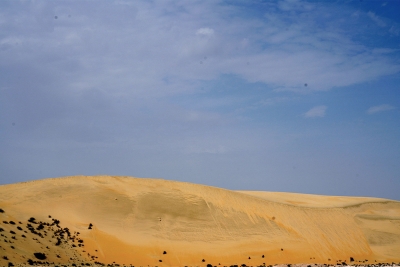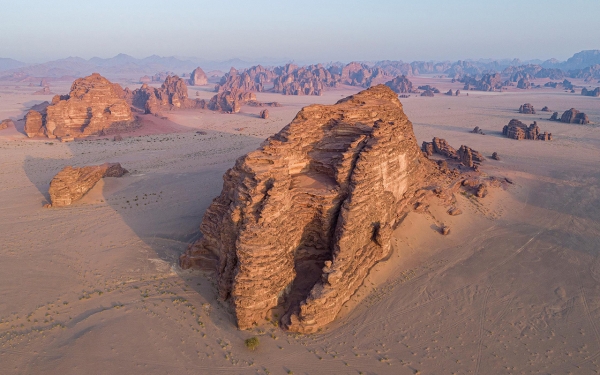
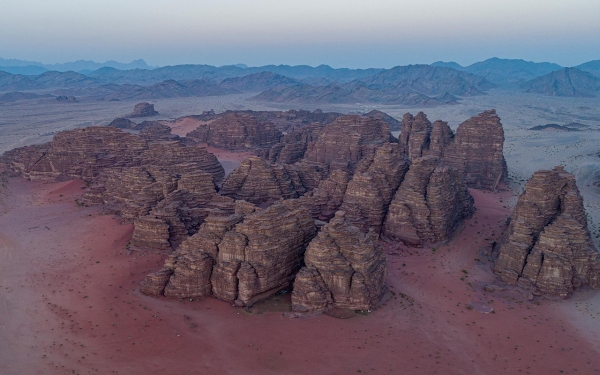
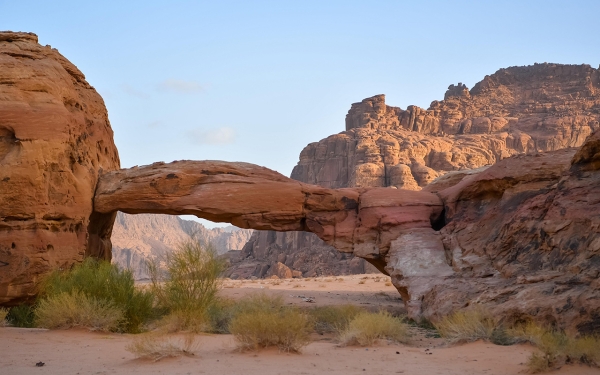
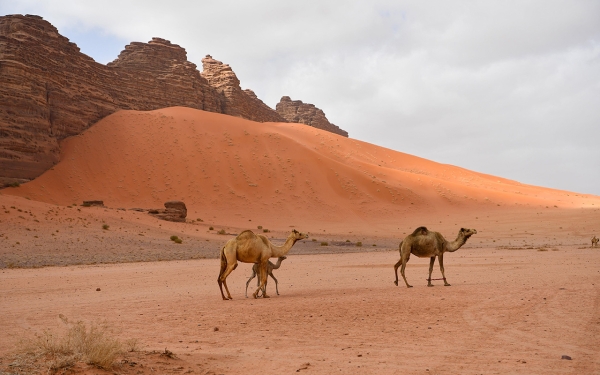
Hisma Plateau is situated northwest of the Kingdom of Saudi Arabia, stretching from the outskirts of Jabal Midian in the west to the edges of Harrat al-Harrah in the east. It also extends into the Jordanian territory in the north. The plateau's elevation ranges between eight hundred and 1,700 m above sea level, slightly increasing towards the center of the plateau, east of Tabuk City in al-Tubayq Province. However, its surface recedes near Tabuk City, forming an inland depression pouring into Wadi al-Akhdar. Except for this depression, the plateau's surface is remarkably flat.
Components of the surface of Hisma Plateau
The plateau's surface is composed of Paleozoic sandstone rocks, represented by Tabuk's formation. Fractures parallel to the Red Sea are abundant, especially near Tabuk, and increase frequently heading west. The western part is characterized by numerous natural formations, separated by flat spaces covered by sand, distinguishing it from the rest of the plateau. Sands cover the slopes of these formations, but there is no evidence of surface runoff. Valleys do not begin to appear until the far west on Tabuk-Duba road, where the western edge of the plateau extends between ten and eighty km west of Tabuk, known as the 'Sandstone Formation Region.' The current condition of the region can be explained as a legacy of a previous climatic period with higher rain rates than the present. The rainfall average in Tabuk is less than fifty-eight mm, and evidence from the region indicates the dominance of wind erosion processes, as wind is currently causing only minor modifications to the landforms.
Cities and villages of Hisma Plateau
Hisma Plateau has several cities and villages, including Tabuk City, Ibn Hirmas Well, Halat Ammar, and Mughayra Village to the east. Bedouin life prevailed on the plateau due to the harsh climatic conditions and water scarcity. However, the discovery of abundant groundwater in the province has enabled the establishment of an agricultural life on a large scale. Modern farms have spread over vast areas to the north and south of Tabuk City, exporting their products to most provinces of the Kingdom.
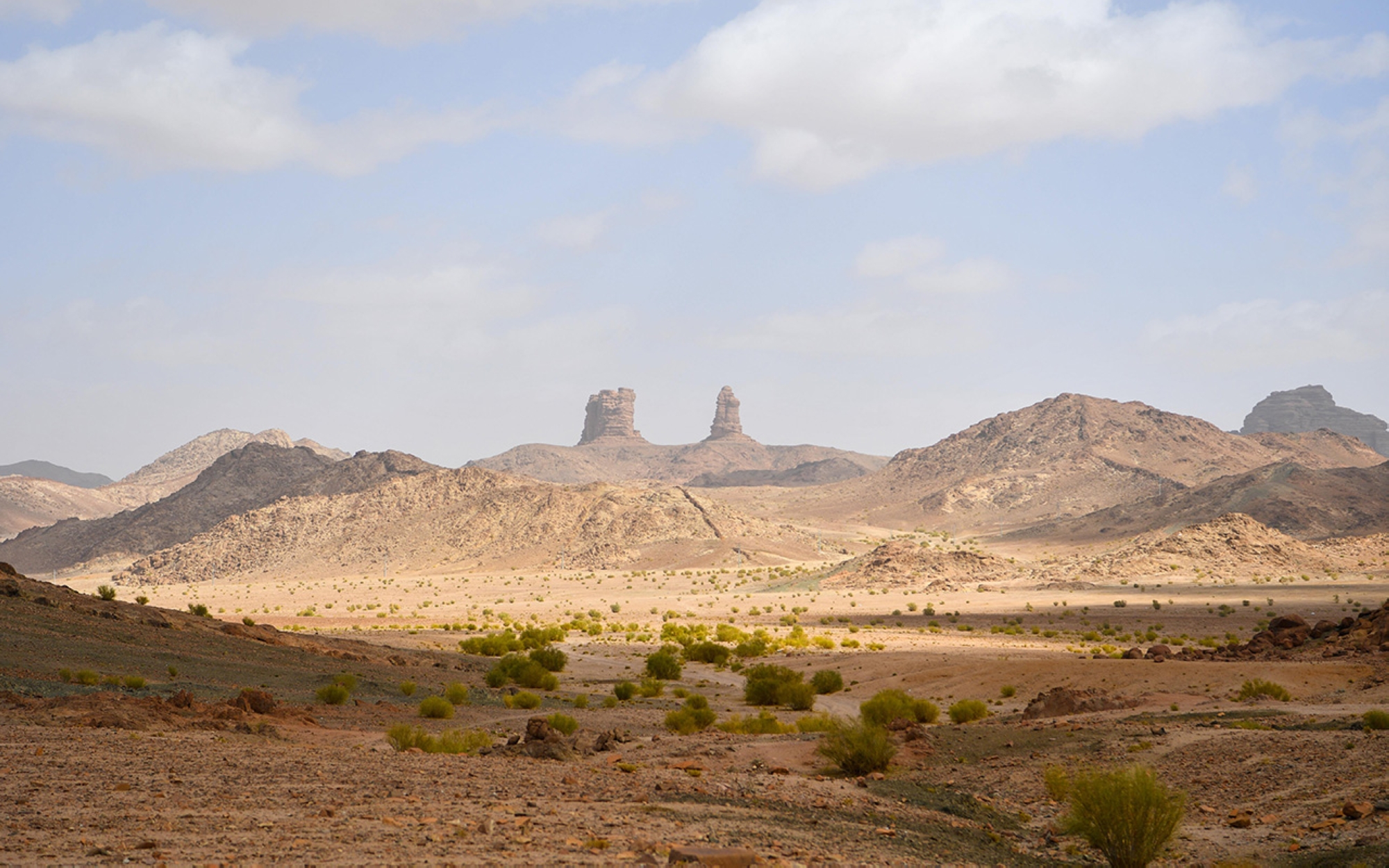
Hisma Plateau in Arabic literature
Hisma Plateau gained significant prominence in Arabic literature. Al-Jawhari described it as a 'desert land with towering, smooth-sided mountains almost always covered in dust'. Yaqut stated that Hisma is 'easily recognized by anyone who has seen it from anywhere, as there is nothing like it in the world'. Furthermore, three ancient routes passed through or near it. The first route is the Coastal Road, running along the Red Sea and then through Wadi al-Jazl. The second route is the Ma'an-Tabuk Road, leading to Mada'in Salih, and the third route goes from al-Azraq to Tayma'.
Kuthayyir says:
Amir al-Mo'menen will come preceeded
by masses of sad and helpless people of Hisma
In his account of al-Mutanabbi and his journey from Egypt to Iraq, Yaqut said: 'Hisma is a good and soft land. It reveals even the footprints of an ant. All kinds of plants grow in it, and it is filled with smooth-sided mountains of different heights soaring up to the sky. To catch a glimpse of their summits, one's neck would be strained. Some parts of it cannot be seen or climbed. It is a three-day journey that may be completed within two days. Among Hisma's mountains lies the towering mountain Iram, which people of the desert claim is filled with vines and pine trees'.
Heights of Hisma Plateau mountains
Hisma Plateau encompasses several mountains including, as-Safinah, al-Dhahr, al-Mihmash, al-Huzaymat, Sudair, Hawsal, al-Madraba, and ash-Shaka'ah. Their streams drain into valleys such as Turf, az-Zaytah, and Damm.
Jabal Iram in Hisma Plateau
The mountain stands at approximately 1,754 m above sea level and is located at the intersection of approximately 35° 25' E longitude and 29° 30' N latitude. The climatic conditions at the peak of Jabal Iram were once suitable for the growth of vines and pine trees, although these trees are no longer present. The mountain is a popular tourist destination in the Tabuk Province due to its diverse colors and unique appearance, resulting from the severe fragmentation of Hisma's surface. This fragmentation is caused by three main factors: the numerous faults spread across the northern part of the region, including the recent fault extending west of Jabal Iram or 'Ramm' mass, through which Wadi Rumman now flows before draining into the Umm Salb basin. The second factor is water erosion. The basins scattered in this region have united a network of valleys from various directions. Additionally, the faults and fractures present on the surfaces of these rocks have facilitated the work of water erosion, expanding the valleys and widening their walls. The third factor is the wind that infiltrates the rocks in its erosive process, as dust clouds cover the region, making it difficult to see even from a close distance. Moreover, the sand deposit that is a result of erosion and weathering is visible from all directions. An-Nabigha al-Dhibyani has alluded to the dust clouds covering the mountains of Hisma, stating:
In the mountains of Hisma
Dust and al-qatam reached maturity
Al-qatam or al-qatam is dust, according to Lisan al-Arab.
Archaeological inscriptions in Hisma Desert
Hisma Desert is well-known for its striking red sands and the sandstone mountains that adorn its northwestern reaches in Tabuk Province. This desert, rich in geological wonders and steeped in history, boasts a diverse array of ancient inscriptions engraved onto its towering cliffs. For millennia, Hisma has served as a crucial crossroads on the ancient trade routes to and from the Arabian Peninsula, witnessing the passage of countless caravans and travelers throughout human history. Buried within its sands lies a treasure trove of inscriptions and writings, testifying to the region's rich historical heritage and its significance to scholars studying the origins and evolution of the Arabic language. In this site, the first Arabic inscriptions were discovered, later known as the 'Hismatic dialect'. Hismatic is an Arabic dialect similar to the Nabataean dialect and is considered the first Arabic script in cursive, like the Kufic script. Hismatic letters resemble the Safaitic script and are distinguished by location and history. These ancient artifacts carry some aspects of the legacy of the Arabian Peninsula and its enduring language.
Related quizzes
Related articles


